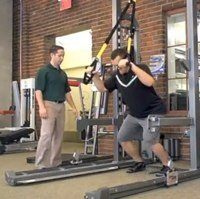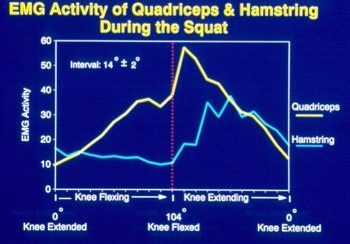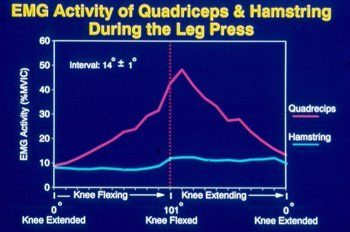The TRX Suspension System is a pretty cool piece of exercise equipment that has some obvious (i.e. rows!) and not so obvious uses. The strength community has shown us tons of great uses of the TRX, but I also personally use the TRX many ways within my rehabilitation programs.
Here is a video of some simple variations to the squat that can be performed by using the TRX. I’ll explain more about why I use these TRX squat variations below, but take a look at the clip first:
Muscle Activity During Squats
Biomechanical studies have shown that altering your center of gravity impacts the resultant muscle activity ratios between the quadriceps and hamstrings. This was demonstrated well in the classic 1996 study by Wilk, Escamilla, and Fleisig publish in AJSM. The authors compared squatting and leg press and found that the plane of orientation of the body produced a significant effect on muscle activity.
During the upright squat, when the center of gravity is fairly neutral, the quadriceps and hamstring muscle groups produced a relative amount of co-conraction during the concentric portion of the exercise:
However, when the leg press was performed and the center of gravity was positioned posteriorly, the contribution of hamstrings to the activity was significantly less:
Basically when performing an exercise where you center of gravity is posterior, such as a leg press or wall squat, you will increase quadriceps activity and decrease hamstring activity. Conversely, if you lean forward during a squatting motion, you will increase the hamstrings contribution. Lastly, a neutral squat with a neutral center of gravity will produce co-contraction of the two muscles.
TRX Squat Variations
These biomechanical findings can be used to alter the ratio of quadriceps to hamstrings during the squat as needed. Clinically, there are times during the rehabilitation process where this may be beneficial.
For example, a patient recovering from ACL reconstruction surgery may benefit from performing neutral squats to facilitate co-contraction and stability of the knee. A patient with a PCL injury may want to perform squats from to neutral to posterior to their center of gravity to reduce hamstring contribution and the potential for posterior shear forces. If you want to facilitate posterior chain involvement during the squat and emphasize hip extension, you may want to lean forward and work on this motor control pattern.
As you can see there are a lot of potential clinical implications.
Using the TRX to perform these squats is very helpful, expecially during the early phases of rehabilitation. The TRX suspension system can take some weight off the squat, enhance balance so the patient can shift their center of gravity more anterior or posterior, and serves as what I like to call “training wheels” to help perform a squat correctly when movement dysfunction exists. Just a small reduction in body weight can enhance motor control and help movement quality during the squat. As the person’s motor control improves, they can ween off the TRX “training wheels.”
What do you think? How have you used the TRX during rehab? These are just a few examples of how using the TRX suspension system can help us tweak an exercise like the squat. Understanding the biomechanics of the squat and what happens on the inside during these TRX squat variations will help us build better programs for our patients and clients.
[hr]







